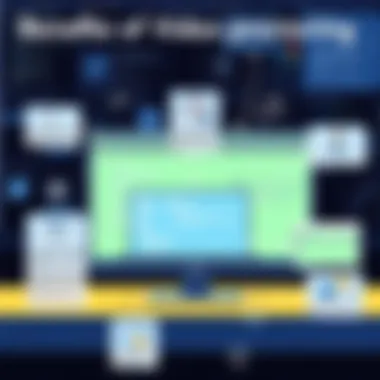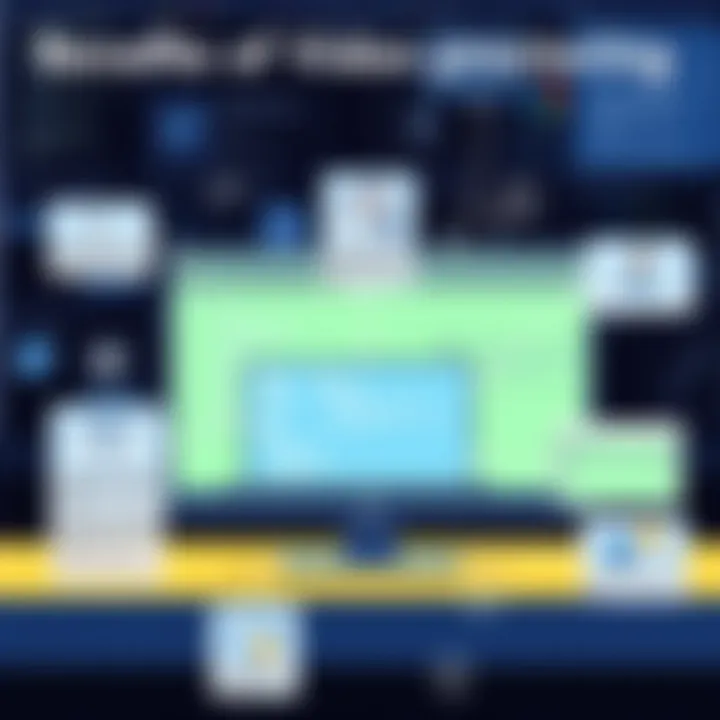Understanding Video Proctoring and Its Implications


Intro
In an era where physical boundaries have been significantly blurred by advancements in technology, the academic landscape has similarly evolved. Remote learning and assessments have become the norm, forcing institutions to adapt to deliver educational experiences effectively. However, with convenience comes complexity, particularly concerning academic integrity. Herein lies the crux of video proctoring – a solution innovatively engineered to fortify the authenticity of online assessments, ensuring that degrees conferred today are as credible as those earned in traditional settings.
This article aims to unpack the layers of video proctoring, from its technical functionalities to empirical evidence on its efficacy, alongside the ethical ramifications at play in its deployment. We venture into the software intricacies, scrutinizing both user interfaces and performance metrics while keeping a keen eye on the overarching objective: preserving integrity in virtual examinations.
Key Points to Explore
- Software Overview: An Insight into Video Proctoring Technology
We will delve into the software that makes video proctoring possible, its key features, and how it operates within real-world settings. - User Experience: Navigating the Digital Proctoring Landscape
The user interface can significantly determine the effectiveness and accessibility of proctoring solutions. We will assess how users navigate these platforms and the importance of reliability in their functionality. - Ethical Considerations: A Double-Edged Sword
With great power comes even greater responsibility. We will confront ethical concerns surrounding privacy, consent, and the potential for bias. - Future Directions: The Road Ahead in Digital Assessments
Finally, we will look toward what lies ahead, considering emerging technologies and their potential to shape the future of online education.
By diving deep into these facets, we aim to provide an engaging and comprehensive narrative that resonates with IT professionals, educators, and decision-makers alike who seek actionable insights amid a rapidly changing educational environment.
Preface to Video Proctoring
In today's rapidly evolving educational landscape, the need for maintaining academic integrity has never been greater. With online assessments becoming a staple, traditional oversight doesn’t quite cut the mustard anymore. This is where video proctoring steps in. It’s not just a monitor; it’s a multifaceted tool that ensures fairness and transparency in evaluations. With educators and institutions leaning heavily into remote learning frameworks, understanding video proctoring becomes critical.
Video proctoring serves as a vital bridge in addressing the challenges related to assessing students remotely. It provides a viable solution to the issues of cheating and dishonesty that can loom large in an unmonitored setting. By deploying technology that observes students in real-time, institutions can foster a sense of accountability, much akin to having a watchful eye in the examination hall. What’s significant about this approach is its dual capability: supporting the integrity of assessments while offering flexibility for students.
Moreover, as the acceptance of online education grows, so does the reliance on video proctoring. It’s essential not only to understand its operational mechanics but also to explore its broader implications on learning outcomes and student experiences. A deep dive into the historical context, technical workings, and ethical considerations can provide clarity on this evolving practice.
Definition of Video Proctoring
Video proctoring is defined as the use of technology—primarily webcams, microphones, and screen recording software—to monitor students during online examinations. This process permits real-time observation while also recording the session for later review. By leveraging digital surveillance, it creates an environment of trustworthiness, aiming to send a clear message that academic honesty is paramount in online assessments.
- Key Elements of Video Proctoring:
- Monitoring: Continuous observation of candidates during assessments.
- Recording: Captures video and audio data for authenticity verification.
- Review: Recorded materials can be scrutinized if any suspicious activity occurs.
Historical Development
Tracing back the roots of video proctoring reveals an interesting journey. It didn’t emerge out of thin air. The rise of technology-assisted examinations began in the late 20th century with the advent of computer-based tests. However, it was the rapid proliferation of the internet and enhanced multimedia capabilities in the early 2000s that paved the way for video proctoring as we know it today.
The first significant implementations came from burgeoning online universities that sought robust measures to safeguard their credentials. As these platforms flourished, so did the necessity of ensuring their assessments held water. In response, several companies dedicated to developing innovative proctoring solutions sprang up, each offering varying levels of surveillance sophistication.
Eventually, emerging technologies such as artificial intelligence and machine learning played a pivotal role in refining video proctoring methods. This historical context not only highlights its evolution but also brings to light the ongoing adaptations that cater to the demands of modern education. With institutions increasingly adopting AI-based algorithms for behavior analysis and facial recognition, the landscape is bound to shift further in the coming years.
How Video Proctoring Works
In the realm of remote assessments, understanding how video proctoring operates is pivotal. This section delves into the technical components, software algorithms, and user interface that constitute the core of video proctoring systems. By grasping these elements, educators and institutions can better appreciate the benefits and intricacies that video proctoring entails in ensuring examination integrity.
Technical Components
Video Recording
Video recording stands as a cornerstone of video proctoring. Its primary focus is to capture the entire examination process visually. This aspect is vital for establishing a record of the student's actions during the test. The quality and clarity of the video become significantly important, as they directly influence the reliability of any potential post-examination reviews. Notably, most systems enhance video resolution, ensuring that every detail is preserved. This characteristic makes video recording a popular choice among educational institutions since it aids in identifying any suspicious behavior effectively.
A unique feature of video recording technology is the ability to integrate multi-camera setups, allowing for comprehensive coverage of the test-taking environment. However, it does present challenges: excessive data storage and potential technical difficulties for users when accessing these recordings can arise. The delicate balance of high-quality video with manageable data requirements is a continual discussion point within the field.
Audio Capture
Audio capture complements video recording by providing an auditory dimension to the examination. This component captures verbal interactions, which might be critical in understanding the context during the examination. Institutions often deem it useful for monitoring discussions during collaborative assessments or to ensure that no external assistance is being received. The key feature here is the ability to filter out background noise, honing in on relevant sounds that might suggest academic dishonesty.
However, audio capture comes with its own set of drawbacks. Many students express concerns regarding privacy, as capturing audio can feel invasive, especially in personal spaces. There’s also a risk of audio misinterpretation, where innocent comments might be misconstrued. Thus, while beneficial, audio capture poses ethical concerns that proctors must navigate.
Webcam Surveillance
Webcam surveillance serves as an additional layer of scrutiny in the testing environment. By monitoring the test-taker in real time, it aims to deter acts of cheating through constant visual oversight. The fundamental characteristic of webcam surveillance is its ability to track physical movements, making it useful in identifying students' attempts to access unauthorized resources.
A unique feature is the capability of adaptive monitoring, which adjusts the level of scrutiny based on the student's behavior. This feature creates a nuanced approach, distinguishing between normal movements and potentially suspicious ones. Nonetheless, the implications for student comfort and the potential for false positives highlight the delicate nature of webcam surveillance. Over-reliance on this technology can lead to undue stress for test-takers who might feel like they are under constant watch, prompting discussions about ethical boundaries in educational tech.
Software Algorithms


Behavior Analysis
Behavior analysis algorithms analyze various patterns in a test-taker’s behavior during an exam. The ability to recognize anomalies such as unexpected movements or prolonged gaze away from the screen is invaluable. Such capabilities signal potential misconduct and provide valuable insights into a student’s engagement and possible intentions.
A significant advantage of this technology is its adaptability, as algorithms can learn from past data. The more an algorithm operates, the better it becomes at recognizing standard behaviors, making it increasingly efficient. However, the reliance on algorithmic predictions raises concern, particularly regarding false accusations stemming from misinterpretations of a student's actions. This represents a gray area in the balance between security and student trust in the integrity of the examination process.
Facial Recognition Technology
Facial recognition technology entails the identification of a student by analyzing facial features. This aspect seeks to ensure that the individual taking the exam is indeed who they claim to be. One of the essential characteristics of this technology is its speed; it can verify identity in mere seconds, streamlining the testing process.
However, this technology is not without controversy. Accuracy can fluctuate depending on various factors such as video quality and lighting conditions. Moreover, privacy concerns loom large, as the use of facial recognition can leave individuals feeling uncomfortable about being constantly monitored. Thus, while facial recognition serves a valuable purpose in enhancing security, its deployment necessitates careful consideration of ethical implications.
User Interface and Experience
The user interface and experience of video proctoring systems play a crucial role in the adoption and effectiveness of these technologies. An intuitive interface can greatly enhance the user experience for both students and proctors. Clear instructions and straightforward navigation minimize potential technical problems during exams. It makes it easier for students to focus solely on their performance without getting sidetracked by complex functionalities.
Furthermore, a good user interface can ease the integration of various technical components—ensuring that video, audio, and webcam features work seamlessly together. Hence, this synergy not only enhances integrity in the examination process but also supports the overall goal of creating a conducive testing environment.
Benefits of Video Proctoring
Video proctoring stands at the forefront of modern education, primarily due to its ability to overcome significant challenges associated with remote assessments. Its introduction has become increasingly relevant, especially in a world where the accessibility of education is paramount. In this section, we will delve into the myriad advantages that video proctoring brings to the table, particularly focusing on three key facets: enhanced security for online exams, cost-effectiveness, and flexibility for students.
Enhanced Security for Online Exams
One of the most cited benefits of video proctoring is its contribution to maintaining the integrity of online examinations. In an environment where physical supervision isn't feasible, relying on technology presents a viable alternative. Video proctoring not only captures real-time footage of the student but also documents the entire examination environment.
"Integrity is like a fine piece of china: once broken, it cannot be repaired."
This idea resonates strongly in academia, where the validity of assessments hinges on authenticity. Video proctoring acts as a digital safeguard against cheating, ensuring that institutions can uphold academic standards. Automated alerts can signal suspicious behavior, prompting immediate investigation, thereby adding layers of scrutiny typically involved in traditional exam settings.
Cost-Effectiveness
Another noteworthy aspect of video proctoring lies in its cost-effectiveness for educational institutions. Traditional proctoring methods demand personnel resources, travel costs, and time investments that can add up rapidly. In contrast, video proctoring streamlines the examination process, offering a potentially lower-cost solution.
Institutions can realize savings through reduced need for in-person staff while still maintaining quality assessments. Furthermore, fees associated with traditional venues are largely eliminated. Schools and universities can also use this technology to accommodate a larger number of students simultaneously, thus optimizing resources.
- Reduced administrative costs
- Increased scalability
- More utilization of existing infrastructure
These factors make video proctoring an attractive option for many organizations looking to maintain robust assessment practices without breaking the bank.
Flexibility for Students
In our fast-paced world, students are often juggling multiple responsibilities, whether it's work, family, or study commitments. Video proctoring caters to this need for flexibility in several ways. It allows students to take exams from virtually anywhere, provided they have a stable internet connection. This facet is particularly appealing for non-traditional students who may be balancing education with other life demands.
Moreover, video proctoring can facilitate a wider range of examination schedules. With less reliance on physical locations, institutions can offer assessments at varied times, accommodating different time zones and personal obligations.
- Online accessibility
- Various timing options
- Less travel-related stress
In sum, video proctoring empowers students to take control of their learning journeys, contributing to a more inclusive educational landscape. Overall, by embracing video proctoring, education systems can enhance security, reduce costs, and offer students the flexibility they need to succeed in a challenging environment.
This comprehensive exploration highlights how video proctoring is not merely a stopgap measure but a transformative tool that aligns with modern educational needs. Institutions, students, and educators alike stand to benefit from its implementation.
Challenges and Concerns
Video proctoring has become a cornerstone of online assessments; however, it does not come without its fair share of challenges and concerns. As we explore these aspects, understanding their significance is crucial for educators and institutions that rely on this technology. Privacy issues, technological limitations, and the impact on student well-being are paramount to consider, as they shape the conversation around the adoption and implementation of video proctoring.
Privacy Issues
One of the key challenges in video proctoring stems from privacy issues. The very idea of having a camera monitor students during an examination raises red flags for many. Are their personal spaces being invaded? Are they being watched too closely? These questions often linger in students' minds, leading to a feeling of unease. In many cases, institutions must navigate a minefield of privacy laws and regulations. For instance, legislation such as the General Data Protection Regulation (GDPR) in Europe imposes stringent requirements on how personal data is handled, including video footage.
Institutions must ensure they provide clear communication regarding data usage, retention, and deletion policies. Consent should be at the forefront; students need to know what they are signing up for when using video proctoring technology. Otherwise, the risk of infringing upon individuals’ rights looms large, leading to potential legal repercussions. Furthermore, developers must prioritize data encryption and secure storage practices to protect sensitive footage.
Moreover, it’s important to establish trust between students and institutions. If students feel that their privacy is compromised, it may affect their performance and overall experience. Introducing robust privacy policies and transparent communication channels could help assuage these concerns. Direct dialogue with students about their privacy rights fosters trust and sets an atmosphere of cooperation rather than surveillance.
Technological Limitations


While video proctoring technology boasts several advantages, it is often burdened with technological limitations. For starters, the efficacy of recording instruments can vary widely based on hardware and network conditions across different locations, leading to inconsistent monitoring situations. A student’s low-quality webcam or poor internet connection might result in unresponsive software, leaving room for loopholes.
Moreover, software algorithms employed for proctoring frequently face challenges in accurately distinguishing between benign actions and cheating; false positives can occur. Think about it: a simple glance away from the screen or a pen placed down can be misinterpreted as suspicious behavior. This can trigger unnecessary alerts and, by extension, undue stress for students who are already facing exam pressures.
Yet another hurdle stems from the integration of software with different educational platforms. Not every Learning Management System is designed to work seamlessly with video proctoring software. This can create operational headaches, where technical issues hinder the proctoring experience altogether.
Ultimately, as technology evolves, so too must the systems that support video proctoring. Solutions that enhance compatibility, improve user experience, and ensure robust performance are vital in alleviating these concerns.
Student Anxiety and Stress
Lastly, the psychological impact of video proctoring cannot be ignored, particularly in terms of student anxiety and stress. Many students entering a proctored environment might feel the pressure mounting, worrying about how they’re being monitored. This stress can ultimately hinder their performance on exams, turning an evaluation process into a contest of managing anxiety rather than demonstrating knowledge.
A study found that surveillance during exams can elevate blood pressure levels and impair cognitive function, proving counterproductive in the learning environment. Therefore, it’s critical for institutions to recognize the ramifications that such scrutiny can impose on students.
Strategies to mitigate these effects include offering familiarization sessions where students can review how proctoring works. Workshops could enable students to practice using the technology, fostering a sense of comfort. Open discussions within learning communities can also help normalize the proctoring experience.
Ultimately, addressing student anxiety requires a balanced approach that weighs the need for security against the emotional and mental well-being of students. Creating a supportive environment that acknowledges these concerns can make a world of difference.
The integration of technology into education should enhance, not hinder, the learning experience. Fostering an environment where students feel secure and understood is key to successful assessments.
Ethical Considerations
In the evolving realm of video proctoring, ethical considerations hold a central place. The technology's rise has made it imperative to discuss not only its benefits but also the ethical dilemmas that surface. This section emphasizes the critical nature of these considerations, advocating for a balanced approach that respects individual rights alongside the necessity for integrity in online assessments.
Informed Consent
Informed consent is the hallmark of ethical research and practice. When it comes to video proctoring, it entails ensuring that students are adequately aware of how their data will be utilized and the scope of surveillance during assessments. For example, before taking an exam, students should receive clear information about what exactly the monitoring entails. This includes details about video capture, audio surveillance, and any data retention policies. It is not fair to spring such practices on students without proper notice, eroding trust.
A methodical approach can enhance transparency. Institutions might consider providing students with an explicit consent form outlining their rights and the extent of monitoring they will experience. This practice not only serves to protect students but also shields institutions from potential legal consequences. After all, students should feel that they are participating in an assessment process that respects their autonomy.
Fairness and Accessibility
The issue of fairness and accessibility in video proctoring is critical to elevating the overall student experience. While technology aims to bolster integrity, it can sometimes introduce new barriers that disadvantage certain groups of students. Take, for instance, students with disabilities, who may require alternative exam formats or additional accommodations. If system configurations do not cater to their needs, it could lead to unfair disadvantages.
Moreover, the digital divide cannot be ignored. Not every student has equal access to high-speed internet or a reliable laptop, and this disparity can impact performance. Institutions must actively seek solutions that offer equitable access for all students. This could involve providing necessary equipment or exploring alternative examination methodologies that can accommodate varied capabilities and resources.
Important Considerations:
- Legal Implications: Institutions must be aware of laws regarding digital privacy and consent in education.
- Institutional Policies: Create robust policies around the ethical use of video proctoring that prioritize fairness.
- Student Feedback: Engage in continuous dialogue with students to adjust practices based on their experiences.
"The ethical landscape of video proctoring is complex, but institutions dedicated to integrity must also commit to fairness in their assessment practices."
By addressing these ethical considerations, institutions pave the path for a more equitable and trustworthy experience that upholds the principles of academic integrity while being mindful of individual rights. This layered approach is not only beneficial but also essential for fostering a respectful educational environment.
Case Studies
Exploring case studies in video proctoring offers rich insights into how this technology is applied across various sectors. These real-world examples provide context to the theoretical underpinnings of video proctoring, illustrating both its practical benefits and potential pitfalls. By examining diverse implementations, institutions and professionals can gather best practices and learn valuable lessons that inform their own adoption and use of video proctoring solutions. Through these case studies, we can see not just successful applications, but also challenges faced and navigated along the way.
Higher Education Institutions
In the realm of higher education, institutions like the University of Illinois and Arizona State University have harnessed video proctoring to uphold academic integrity during remote examinations. These universities have reported a range of benefits from its integration.
- Enhanced Examination Integrity: By using platforms such as Respondus Monitor, schools enable students to take tests from their chosen locations while ensuring that any instances of cheating are minimized through real-time monitoring.
- Data Analysis for Continuous Improvement: Institutions leverage data collected during proctoring sessions to identify trends in student behavior. For instance, the frequency of suspicious activity can provide insights into areas where students may need additional support or resources.
- Flexibility in Testing Environments: As many colleges shifted to online formats amid the pandemic, video proctoring proved to be a lifeline that allowed assessments to continue without significant disruptions.
However, challenges like ensuring all students have access to the necessary technology for video proctoring create disparities that institutions continue to address.
Professional Certification Programs
Professional certification programs also illustrate compelling applications of video proctoring technology. Certifying bodies like the Project Management Institute (PMI) and Cisco have utilized remote proctoring to administer high-stakes exams.
- Maintaining Professional Standards: By incorporating proctoring solutions, these organizations ensure that their certification processes maintain robust standards of integrity expected in professional fields.
- Global Accessibility: Many professionals seek certifications to enhance their career prospects, yet geographic barriers can hinder access to testing centers. Video proctoring enables professionals worldwide to sit for exams without the need to travel, thereby democratizing opportunities for career advancement.
- Technology in Action: Programs like PSI Services provide comprehensive monitoring that includes identity verification and behavioral analysis, establishing a rigorous process that caters to the expectations of both certifying bodies and candidates.
Future Trends in Video Proctoring


Video proctoring is not resting on its laurels; it's a dynamic field that is constantly evolving. The importance of understanding future trends in video proctoring lies not just in gauging its current effectiveness but also in predicting how these advancements can enhance the integrity and accessibility of online assessments. By examining where the technology is headed, educators and institutions can remain one step ahead, ensuring that they are prepared to address emerging challenges while maximizing benefits.
Advancements in AI Technology
Artificial intelligence is disrupting numerous fields and video proctoring is no exception. Future advancements in AI technology promise to not only improve accuracy but also streamline the entire proctoring process. Here are some key points worth noting:
- Automated Detection of Irregularities: AI can analyze video footage in real-time to flag unusual behavior patterns, like looking away from the screen or the presence of unauthorized materials. This minimizes the reliance on human reviewers, making the process more efficient.
- Machine Learning Applications: By utilizing large datasets, machine learning algorithms can learn from previous testing instances, continuously improving their understanding of honest versus potentially dishonest behavior.
- Enhanced User Experience: AI isn't just working behind the scenes; it can also facilitate a smoother experience for test-takers. Instead of manual check-ins, AI could guide students through the setup process, reducing pre-exam anxiety.
This integration of AI technology could revolutionize not just how exams are monitored, but also how data regarding student performance is utilized for pedagogical improvements.
Integration with Learning Management Systems
As online education becomes more prevalent, the integration of video proctoring solutions with Learning Management Systems (LMS) is essential. Such integration can offer several benefits:
- Streamlined Processes: By housing proctoring tools directly within existing LMS platforms, institutions can eliminate redundant systems, making it easier for both educators and students to navigate.
- Data Synchronization: With integrated systems, exam results can be automatically fed into a student’s record without requiring extra steps or manual entry — an error-prone process that can undermine data integrity.
- Holistic Learning Environment: Having video proctoring within a familiar learning platform can provide a more seamless experience. Students won't have to juggle multiple applications, which helps keep anxiety at bay.
In summary, future trends in video proctoring promise transformative changes that can enhance academic integrity while adapting to the needs of both students and educational institutions. As technology advances, it’s crucial to stay informed about these developments to enact best practices and effectively integrate them into existing educational frameworks.
As we look ahead, we can see that the future of video proctoring will require a careful balance of technology and pedagogy, ensuring that the advancements serve to enhance the learning and assessment processes in a meaningful way.
Best Practices for Implementation
When integrating video proctoring into educational or certification settings, it's critical to adopt best practices to ensure effectiveness and minimize disruptions. These practices not only address operational complexities but also enhance the overall experience for all stakeholders involved.
Training for Educators and Proctors
Training is paramount. Not only does it empower educators and proctors with the necessary skills, but it also instills confidence in their ability to handle technology. A well-trained staff can identify issues swiftly, ensuring a smooth testing experience. Programs that cover the following areas can be beneficial:
- Understanding Software Mechanisms: Proctors need a solid grasp of the tools at their disposal. Training should cover the specific video proctoring software's functionalities, as it's a different beast from traditional assessment methods.
- Recognizing and Managing Technical Issues: If something goes awry, having a handle on troubleshooting can save time and reduce stress. Clear protocols should be established to address common problems that can pop up during exams.
- Ethical Best Practices: Educators must be aware of ethical implications, including privacy concerns and addressing them with proper decorum.
- Handling Student Interaction: Proctors should be trained on how to interact with students, especially when addressing potential violations of testing protocols. This helps maintain a professional atmosphere, minimizing misunderstandings and anxiety.
Training sessions can be delivered through workshops, online courses, or even peer mentoring. The key is to keep these sessions engaging and focused, ensuring that all participants are on the same page before exams begin.
Establishing Clear Guidelines for Students
The foundation of a successful implementation lies in how well students understand what is expected of them. Clear and precise guidelines can make a world of difference in how students approach video proctored exams. Here are fundamental elements to include:
- Pre-Exam Instructions: Provide students with written guidelines that include technological requirements, like a reliable internet connection and compatible devices. Clarity on what can and cannot be used during the exam is vital.
- Testing Environment Compliance: Students should know the rules regarding their exam surroundings. Are they required to be in a quiet room? Can they use their notes? Setting boundaries helps maintain integrity while allowing for personal comfort.
- Conducting the Exam: Clear instructions about how the exam will be monitored, including what types of behavior will raise red flags, is essential for transparency. Include visuals if necessary, to help illustrate expectations.
- Post-Exam Procedures: Outline steps for technical issues, what to do after the exam, and how results will be communicated. This preparedness can alleviate confusion and anxiety.
"In the world of remote assessments, clarity is king. Without it, even the best systems can falter."
Establishing these guidelines can foster trust and calm among students. They should not feel they are walking into a minefield but rather a structured environment where they know the rules.
By implementing these best practices, institutions can create a robust framework for video proctoring, ensuring that assessments are fair, secure, and efficient. As this technology continues to evolve, staying informed and adaptable will be key.
For more comprehensive guidelines on training and assessment, check resources such as edutopia.org, or chronicle.com.
End
The conclusion serves as a crucial element in summarizing the extensive discussions surrounding video proctoring in the context of online assessments. It not only encapsulates the significant points explored throughout the article but also reinforces the relevance of video proctoring as a pivotal tool in maintaining academic integrity.
Summary of Key Points
In the journey through this article, several key points emerge that highlight the multifaceted nature of video proctoring:
- Definition and Purpose: Video proctoring offers a technology-driven solution to ensure the security and authenticity of online examinations, adapting to the evolving educational landscape.
- Operational Mechanisms: Various technical components, such as video recording, audio capture, and algorithms for behavior analysis, underpin the functionality of video proctoring systems.
- Benefits: From enhanced security to cost-effectiveness, institutions and students experience numerous advantages, paving the way for more flexible assessment methods.
- Challenges: However, issues like privacy concerns, technological limitations, and student anxiety remain areas requiring attention and improvement.
- Ethical Considerations: Informed consent and ensuring fairness are fundamental to implementing video proctoring responsibly in educational settings.
- Best Practices: Proper training for educators and transparent guidelines for students are essential for smooth deployment and adoption of proctoring systems.
- Future Trends: The ongoing advancements in AI technology and their integration with learning management systems are expected to shape the landscape of video proctoring further.
Final Thoughts on Video Proctoring
As we look to the future, the importance of adapting to new technologies like video proctoring cannot be overstated. It's more than just a tool for cheating prevention; it's a reflection of the continuous evolution of educational assessment methods.
- Embracing Innovation: Institutions aiming to maintain credibility in their assessment processes must embrace these innovations while taking measures to ensure that they address existing concerns.
- Holistic Approach: Balancing technological advancements with ethical considerations creates a symbiotic relationship that benefits both educators and students alike.
- A Forward Path: The transformative potential of video proctoring suggests that it will play an increasingly prominent role in how we assess learning outcomes, thus requiring constant reflection on its impact, effectiveness, and societal implications.
"Technology is a double-edged sword; it can uplift learning experiences while presenting new challenges--it is up to us to wield it wisely."
For deeper insights into video proctoring and its implications, consider exploring further resources:
- Wikipedia on Video Proctoring
- Britannica: Understanding Online Assessments
- Educational Technology articles on edutopia.org
By understanding the complexities surrounding video proctoring, we equip ourselves to make informed decisions that foster integrity in assessments for years to come.







